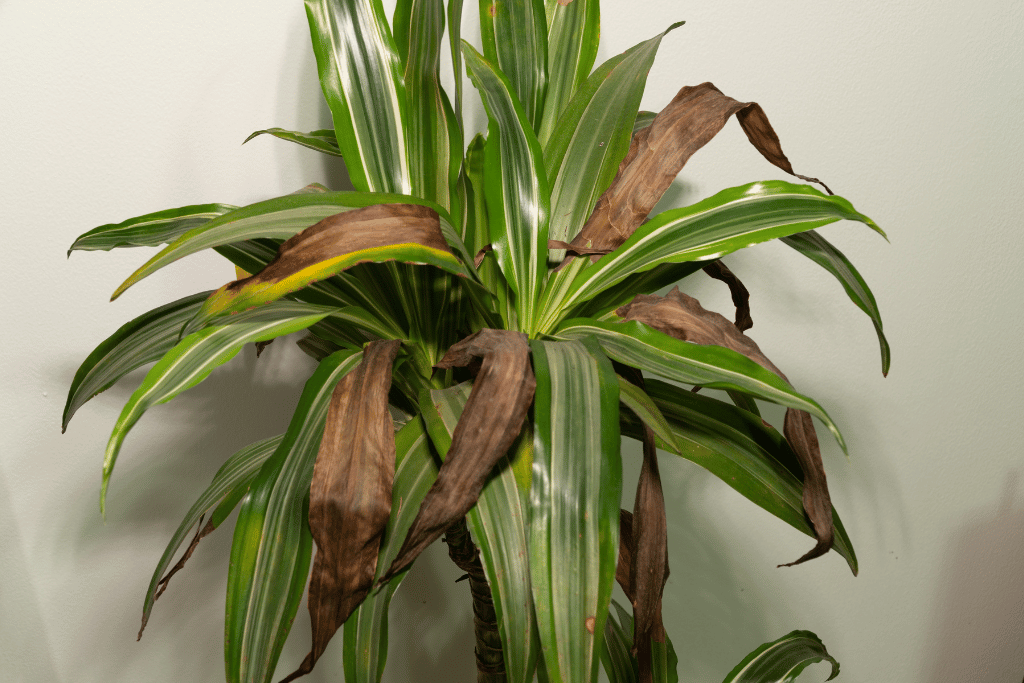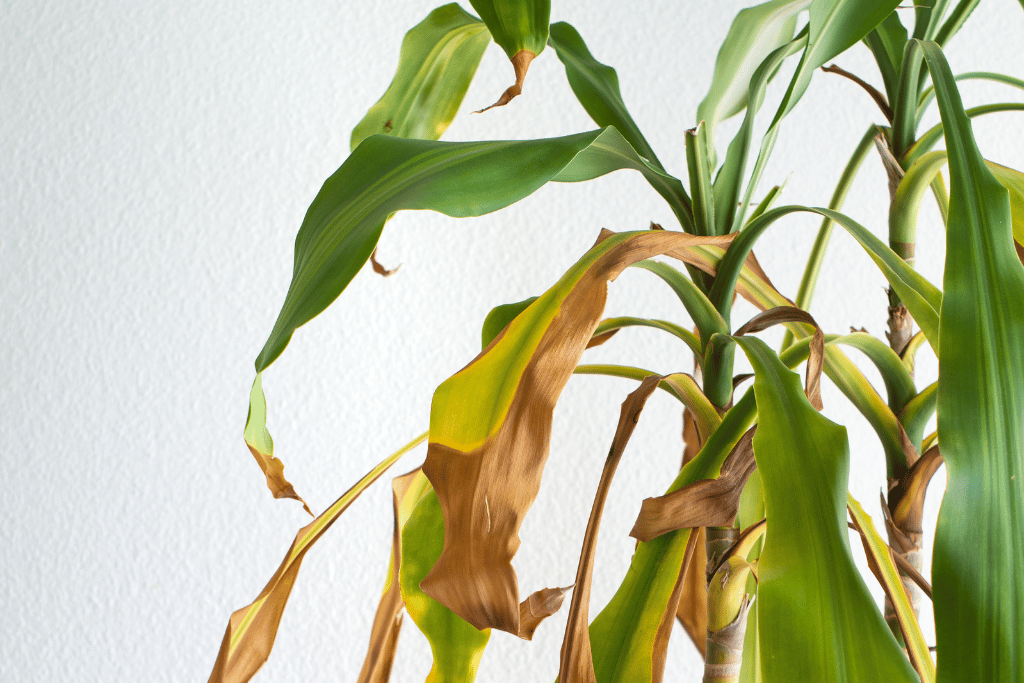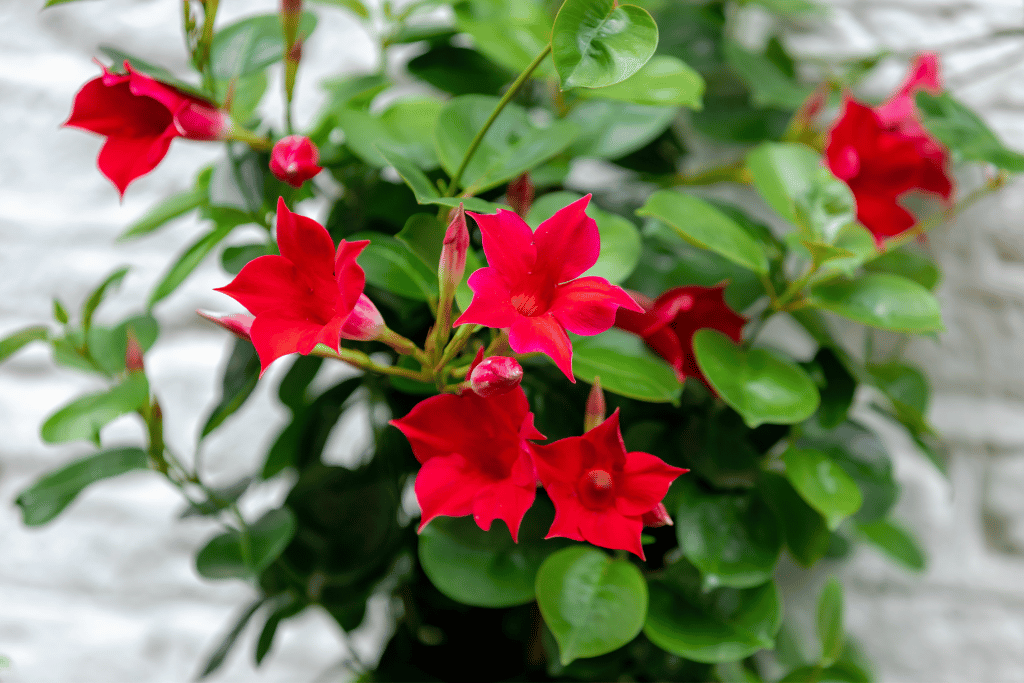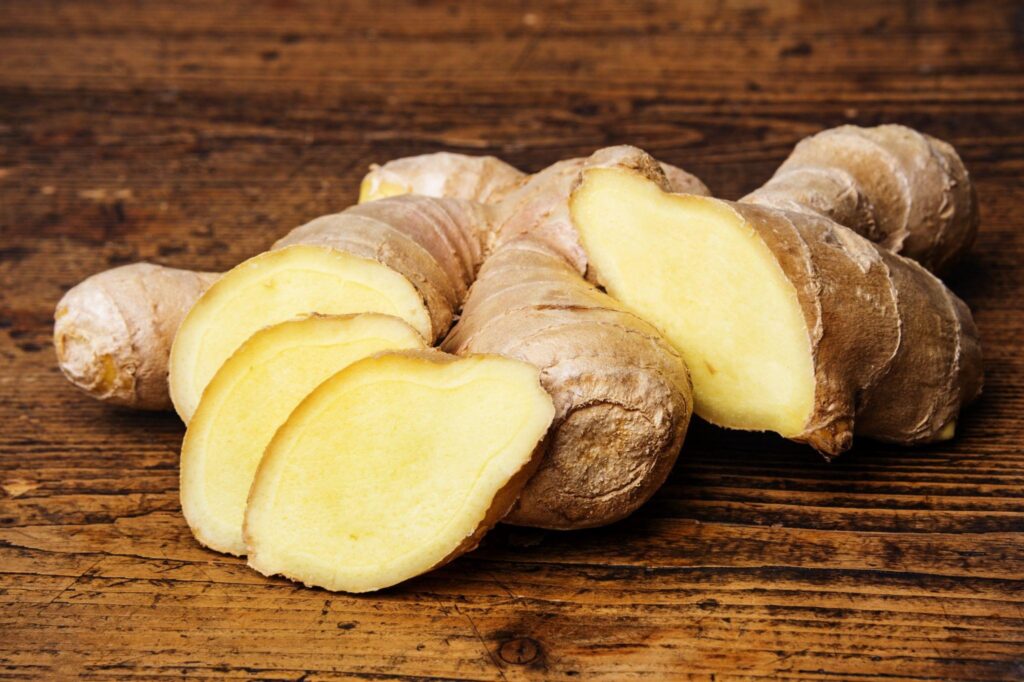
Corn plants are of the genus Dracaena, consisting of over 100 species of succulent shrubs and trees. Dracaena fragrans is the species most commonly kept as a houseplant due to its low-maintenance lifestyle.
The common name, corn plant comes from its growth habit. Tall, skinny leaves shoot straight up from the central stalk in a similar fashion to corn.
I understand the comparison, but to me, it doesn’t very much resemble a standard corn stalk. Maybe we should consider a new and improved common name for this unique plant?
No matter, because these tropicals are popular as houseplants, yet are prone to problems if their basic requirements aren’t met.
Read on to learn how to recognize symptoms, address the situation and ultimately solve the problem of a dying corn plant.
What Is Causing Your Corn Plant to Die?

It’s a dismal sight when you find signs of ill health in your corn plant. Provided the right conditions, this plant is famously low-maintenance and tolerant of neglect. But now your corn plant seems like it’s dying.
So what gives?
- Drooping Yellow leaves
- Brown Scorched Leaves
- Brown Tipped Leaves
- Curling Leaves
All are signs of concern.
The first step of fixing a problem is always to diagnose the cause. Appearance alone can be deceiving, it’s important to observe the conditions of your corn plant.
This will give us a starting point from where we can address the issues. There are many possible reasons your corn plant is dying; luckily for every problem, there is a solution.
Let’s examine some common causes of death to corn plants.
Overwatering
Like the vast majority of indoor plants, overwatering could be the cause of death in your corn plant. Trying to keep your plant moist and happy seems like the right move, but chances are you’re trying too hard.
The fact of the matter is most Draecana varieties only need to be watered once every 2-3 weeks. Soil should be allowed to dry out some in between waterings. Corn plants that are kept in cool, damp soil for any extended period of time will soon experience health problems that could lead to death.

Root Rot
Crispy brown tips and edges on your leaves might be a sign of root rot. This is the worst-case scenario for your corn plant, as root rot is difficult almost impossible to correct if it isn’t caught early on.
Root rot is a direct consequence of overwatering and rapidly kills plants if it’s not addressed. Check for root rot by gently sliding the plant out of its container to examine the roots.
White or light brown roots are healthy. If the roots are black, have turned to mush and smell terrible, it’s definitely root rot. The plant is salvageable if the base of the stalk isn’t rotten and there are some healthy roots left.
How to Fix Root Rot
- Sterilize a pair of gardening shears and trim all dead roots off the root ball.
- Rinse the remaining soil off of the roots.
- Cut off the damaged leaves and trim the foliage back so it reflects the size of the remaining root ball.
- Put your corn plant into a new container with dry soil.
- Water slowly, making sure it drains well.
- Get rid of the infected soil and foliage.
- Sterilize the old container and cutting tools.
- Let the plant be for a couple of days and observe how it takes.
Too Much Intense Light
Corn plants prefer bright indirect light. Too much light or direct sun will scorch the leaves, leaving them brown and crispy.
Move your corn plant to a shadier area and make sure the soil isn’t too dry. When the plant is in a warm temperature and full sun, it’s also likely that the soil will dry out.

Underwatering
Leaf tips will turn light brown and crispy when plants are underwatered. Feel the soil to gauge its moisture level. If the plant feels really light and the soil is dry, it’s definitely time to water.
Slowly give your corn plant a small amount of water until the soil begins to absorb it. Keep an eye on the plant, making sure the soil is moist. It should perk up within a couple of days. The brown leaf tips can be trimmed off.

Too Much Fertilizer
Dracaena plants rarely need to be fertilized. Once in the spring and one more time in the summer should be more than enough. Use a liquid fertilizer at half strength and check how your plant responds.
Even better than fertilizing is refreshing your plant’s soil once in a while by adding compost or potting it up to a larger container.
If you fear that you have overfed your plant, thoroughly rinse the roots with running water for 5 minutes.
Humidity
A less likely problem, but possible nonetheless, is low humidity. 40-50% air humidity is the sweet spot for corn plants. A little higher is fine but lower than 40% can stress the tropical plant.
A humidifier can be used to bring up ambient moisture levels. Try adding pebbles to your plant’s trays. Fill the tray with water and let the pot rest on top of the pebbles to benefit from the evaporating moisture.
An occasional misting of the leaves can help raise humidity levels as well. After misting leaves wipe them off to remove collected dust. Your corn plant will appreciate the clean leaves and will photosynthesize more effectively.
One more crafty way to increase humidity is to huddle together groups of indoor plants. It will create a microclimate where moisture from transpiration and evaporation are shared, leading to a rise in humidity.

Pests & Disease
There are a few pests that will commonly attack your corn plant. Aphids, mealybugs and mites will seemingly appear out of nowhere to attack your plants. Fortunately, they’re easy to notice and dispose of.
Organic pesticides like neem oil or horticultural soap are safe and effective to use in the home. A dusting of the foliage and soil surface with diatomaceous earth is extremely effective as well.
Like with pests, corn plants tend to stay healthy and disease free when they are provided with optimal conditions. But fungal diseases on foliage are not uncommon.
Using a sterilized set of scissors or shears, cut off all the damaged foliage. Spray an indoor plant specific fungicide onto the remaining vegetative growth. A hydrogen peroxide and water solution is an effective and non-toxic antifungal.

How to Prevent Problems and Maintain Corn Plant Health
The best way to prevent all of these problems from plaguing your corn plant is to nip them in the bud. Your main objective should be to maintain ideal growing conditions to ensure good health.
Below are descriptions of the ideal corn plant environment to strive for.

Water Adequately
Err on the side of caution when it comes to watering your corn plant. Typical to other tropical plants, it will need just enough water to keep the soil evenly moist; never soak it.
Thorough bi-monthly waterings should be more than enough. Just make sure the soil never dries out completely.
During the wintertime, especially if exposed to cooler weather, corn plants will go into dormancy. Their water intake will be significantly limited. Be sure that the soil is moist and one watering per month should do the trick.
Test the soil moisture by sticking your finger into the container a couple of inches deep. If it feels moist, retest again in a couple of days.
If it’s dry, then water the plant evenly until it runs out of the drainage holes. Let the plant sit in its tray for 10 minutes to absorb excess water before pouring it out.
Don’t let the plant sit in the water for an extended period of time. We’ve seen how this can cause big problems.
And of course, if you keep your plant outdoors more frequent watering will be required.

Use a Well-Draining Medium
Because corn plants don’t really like being in direct sun, the water in their pots tends to evaporate at a slow rate. This can be a hazard to roots that need to breathe and experience a light drying out from time to time. Therefore, excellent drainage is required.
Use a cactus/succulent potting mix to ensure that the medium won’t hold too much water. If using regular potting soil, consider mixing in a drainage component like perlite, vermiculite or coarse sand. Free-flowing drainage is imperative.
Ensure Proper Lighting
Dracaena plants really like the light, as long as it’s indirect or filtered. Exposure to direct sun can dry out and scorch foliage.
Set up your corn plant in a bright location and use a window shade or other plants to break up the intense bright rays of the sun.
Dracaena varieties with variegated foliage may need a bit more light exposure to retain their bright colors and markings. If these begin to fade, gradually move them to a brighter location to reestablish their distinctive patterns and colors.

Warmth and Air Flow
Keep your corn plant in a steady, warm temperature with plenty of circulating air. The ambient temperature should be within the range of 55-75 degrees. Don’t set the plant near any heating or cooling sources. Drastic swings in temperature will stress the corn plant, leaving it prone to getting sick. The more stable the temperature the better.
Constantly moving air is one of the best ways to prevent disease and pests from attacking your corn plant. A well-ventilated room with a ceiling fan, oscillating fan or open window is a great way to circulate air.
Repotting Your Corn Plant
Corn plants grow slowly but will definitely benefit from the occasional repotting. Plan on repotting your corn plant at least every two years. It doesn’t necessarily have to be a larger pot if the roots don’t warrant it, but new soil and an addition of compost will rejuvenate the plant.
Early spring is a good time to replant. Your corn plant will likely be dormant and ready to return to actively growing, a perfect time for fresh soil. Don’t repot while the plant is budding or blooming.
While you’re repotting check for and trim off any dead roots. Water it in lightly, set it out of direct sun and don’t fertilize for a couple of months until it’s well established.
Pruning
Trimming your corn plant is an effective way to customize its height, shape and overall look. Once it’s cut short, it will retain that height for a while, changing into a bushier structure. There are some health implications to pruning as well.
Clip off any damaged or unhealthy leaves at their base. This will help ensure that the plant isn’t expending energy on weak foliage, improving plant vigor and decreasing overcrowding.

Propagating
Another possible way to save your corn plant in poor condition is by propagating it. The process is simple and could help your plant live on.
Cut off a healthy stem 2 inches below the leaves. Then, insert the stem into a freshly prepared pot of well-draining soil. Roots will eventually sprout from the cut site, growing into a clone of the mother plant. Keep the soil moist and the air humid to aid root development.
It’s a great way to try to salvage your corn plant or simply add to your collection so you can share with family, friends and neighbors.
Was This Article Too Corny?

Taking care of corn plants is simple!
There are plenty of ailments they may encounter, but now we know how to prevent and correct these problems.
Yet, I still don’t see why Dracaena deserves the common name corn plant. I just get the feeling they wouldn’t do so well growing in the middle of Iowa.
The genus name Dracaena in fact comes from an ancient Greek word meaning “female dragon.” Wouldn’t that name sound a bit cooler?
The dubious name of the corn plant may remain a mystery, but at least we now know how to save one that is dying.
Problem solved!
Now good luck and have fun growing your Distaff Dragon Plant; er I mean corn plant!
Frequently Asked Questions (FAQ)
How does an overwatered corn plant look?
Yellowing leaves with brown tips is a good indicator that your corn plant has been receiving too much water.
Is it a good idea to cut off the brown leaf tips of my corn plant?
Brown tips can be safely cut from the leaf. Use a sterile tool and leave a small edge of brown on the leaf to avoid cutting into the fresh, healthy leaf.
Can I mist my corn plant?
Yes, corn plants will take well to misting. It can be especially helpful when humidity levels in the air are low. Don’t overdo it though. Monitor humidity levels and mist accordingly, you don’t want to promote any fungal diseases through wet foliage.
When should I repot my corn plant?
If the soil in the container seems to be drying out too quickly to keep up with or roots are growing out of the drainage holes, it would be a good time to pot up to a larger size container. In the spring, before new growth begins is the ideal time to transplant.



